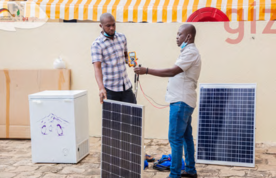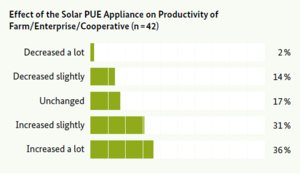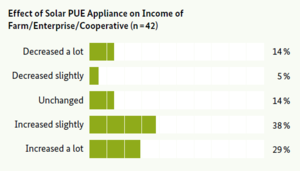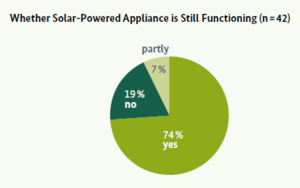Click here to register!
Difference between revisions of "Promoting Productive Use of Energy in Ivory Coast"
***** (***** | *****) Tag: 2017 source edit |
***** (***** | *****) m (Hector Alfaro moved page Promoting Productive Use of Energy in Côte d’Ivoire to Promoting Productive Use of Energy in Ivory Coast without leaving a redirect) |
Latest revision as of 17:52, 23 April 2024
Promoting Productive Use of Energy in Ivory Coast
Project Approach
As of 2020, 70 % of Côte d‘Ivoire’s population had access to electricity. Urban areas, in fact, are very well equipped with grid access in the regional comparison in West Africa. But in the countryside, access might still be lower than 40 %, based on expert judgement. This limits the ability of the rural population to engage in incomegenerating activities. The project offers financial incentives to solar companies for selling and installing solar refrigerating systems and solar water pumps for commercial purposes to develop a market for such equipment in Côte d’Ivoire, particularly in off-grid rural areas. Fridges specifically are seen as a productive use of energy (PUE) appliance, which can increase the productivity of existing businesses and foster local economic growth.
The Green People’s Energy project (Grüne Bürgerenergie, GBE) uses a results-based financing (RBF) approach, whereby solar companies receive financial incentives based on the number of products sold to the target group, and only once the products have been sold and installed. With these, companies are incentivised to identify customers in rural regions and to expand their business areas. The solar companies can develop their own strategy on how to identify customers and sell solar cooling appliances, within defined limits of quantity and quality and benefit from these capacities beyond the duration of the project. Disbursements of incentives occur upon verification of the installation. Larger companies sell solar-powered appliances embedded with smart meters and remote switches, allowing these companies to offer a pay-as-you-go (PAYG) model for purchase. This allows end-users to pay in instalments, thus, making solar PUE appliances more accessible.In addition to providing these incentives, the project supports agri-cooperatives and individual farmers in developing profitable business cases for PUE appliances. With these business models, exchanges between suppliers and end-users of solar technology are organised to promote solar cooling devices. These activities are supported by the Ivorian agricultural extension service CSA and NGOs like CARE International. They are complemented by training of sales agents and technicians, as well as training of the end-user on the proper use of the purchased equipment. To ensure the support of high-quality appliances, only products tested by CLASP are eligible for the RBF programme. Furthermore, testing of different PUE technologies is carried out in collaboration with CLASP to adapt the project approach to local needs. For instance, additional activities to demonstrate solar irrigation pumps and solar sprayers
Methodology of data collection
The data for this case study report was collected through a review of project documents, three qualitative interviews with representatives of the GBE programme and representatives of two companies selling solar refrigerators and solar irrigation pumps. In addition, a quantitative survey was conducted among 44 small businesses, most of whom had purchased a solar refrigerator. 42 of them participated in the survey (only 39 of the respondents have solar fridges). The case study was conducted between April and May. At that time, some project activities were still ongoing. As a result, the impacts captured are not exhaustive.
Key findings
Project Achievements
At the time of writing this case study, overall, about 150 solar appliances have been sold. Of these, 106 solar refrigerators have been installed, verified and incentives have been disbursed for them. The solar refrigerators (with a capacity of 200 l – 250 l) are used to cool drinks and food such as vegetables, fish and other food, that spoil quickly in the heat. This contributes to generating additional income for the beneficiaries. Also, solar sprayers and solar pumps have been promoted and are now being used by the beneficiaries. The sprayers are used to apply pesticides in the fields, while the pumps are used for irrigation.
To showcase PUE devices such as solar pumps, solar sprayers, and solar dryers, a demonstration site has been established on the campus of the GBE office in Abidjan. For demonstration purposes, this site is equipped with a water tower and a vegetable garden. The project also added to the expansion of the solar businesses, but not at a level where the end of the project would constitute a challenge for the businesses. The proportion of equipment installed with the support of the project has reached 20 % – 30 % of the annual turnover of the participating solar companies, according to the representatives interviewed.
Intermediate Impact
Small businesses, cooperatives, and women’s groups can venture into new income-generating activities, such as selling fish. This generates additional income for the small business owners and increases the autonomy of the rural communities, who are able to provide goods and food locally. 67 % of the end-users surveyed report that their productivity as well as their income has increased.
A reason for increased productivity is that food spoilage can be significantly reduced through cooling, for example for fish and fresh fruit. But 16 % state that their productivity has decreased, and 19 % report that their income has decreased (Figures 2 and 3).
Climate Impacts
Solar appliances with a total capacity of 48.2 kW have been installed during the project. According to the calculation methodology of the United Nations Framework Convention on Climate Change (UNFCCC), these installations are estimated to avoid 57 t CO2 e/a in the year of installation, as access to renewable energy avoids access to energy from fossil fuels. This is estimated to be equivalent to the annual CO2 emissions of more than 40 mediumsized cars in Germany.
Challenges in Project Implementation
PUE appliances and PV equipment do not have the best reputation in Côte d’Ivoire, especially in rural parts of the country. The offer on the market is unfortunately characterised by low-quality products that are sold without a warranty and/or an after-sales service. The poor reputation and prejudices against solar devices in general also apply to intermediaries like non-governmental organisations (NGOs) and representatives of the government.
The involvement of stakeholders such as the Agricultural Service Centres (CSA), the NGO CARE International and local partners such as ADAD, CEM, cooperatives and microfinance institutions, as well as the sensitisation of the target groups helped to convince the cooperatives and individual farmer of the advantages of solar-powered equipment. The main benefits are lower running costs, reduced maintenance requirements, time savings (otherwise required e.g., for the purchase of diesel fuel), and reduced environmental impact. Once installed, the solar PUE appliances need to be verified onsite by both, the supplier and GIZ/GBE, which requires travel to remote regions. Reaching these areas is time-consuming for the suppliers, which is part of the reason why the market is thin, and solar appliances are expensive. In addition, for the results-based financing, third-party validation required an additional trip to the sites. Both the suppliers and the project management need to be flexible and adapt to the real situation on the ground.
Administrative procedures and the Covid crisis have caused additional delays in implementation. For small and medium-sized solar companies, in particular, the unfunded lead time presents a challenge. Against this background, both the solar companies and the GBE project management consider the project duration for the implementation of an RBF-support scheme of only one year to be too short.
Other challenges include the correct use and maintenance of the solar PUE units. For example, users have had to learn that refrigerators that are overloaded with refrigerated goods may not cool sufficiently. The handling and cleaning of the solar panels and the correct charging and discharging of the batteries is also a challenge for the clients, as they have no experience with such electrical appliances. For this reason, the project provided training for end-users on proper operation and maintenance. Due to the relative complexity of the appliances, handling and operations are not easy, and after-sales services are very important. After-sales services were included in the purchase contract but initially, some customers were not informed about that fact. The GBE project management successfully urged the suppliers to reliably communicate the additional service to the customers. Finally, the issue of disposing/recycling used batteries remains unsolved. There is a risk of environmental pollution if the solar batteries are not recycled.
Lessons Learned
A key factor for the success of PUE projects is the ability of customers to pay the instalments for their solar appliances. Nursery owners and egg producers have been found to be the most reliable in this regard due to their regular income. Close cooperation with NGOs was identified as another important success factor, as they play a crucial role in linking the different stakeholders (end-users, CSAs, microfinance institutions, suppliers). Based on their experience, NGOs know the situation of farmers in remote areas and can „translate“ their needs for agricultural equipment and inform them about the potential of RE. In addition, political will has facilitated the implementation of the intervention. The project’s documentation of the sales and condition of the solar systems is already being used by the Ministry of Energy (MoE) to plan future electrification measures. The staff of the MoE and NGOs should receive further training (technical and organisational) on PUE to enable them to participate in new projects.
Regarding the choice of the appropriate solar refrigerators, the beneficiaries would have benefitted more from larger cooling capacities of 600 l instead of the 200 l – 250 l size refrigerators that were traded in this project. This is a technical lesson to be considered in future projects. Solar pumps can run without diesel and therefore have very low operating costs. But stakeholders pointed out that investment costs are very high. They gave the numerical example that compared to diesel pumps, solar pumps cost almost four times as much (€1,100 vs. €300), pump less water per day (6,000 l vs. 20,000 l) and require a larger water reservoir (up to 3,000 l vs. 1,000 l), to compensate for periods with no sunshine. This poses an affordability barrier for customers even if the cost of a litre of pumped water over the lifetime of the pump is much less expensive.
This barrier can be mitigated with financing. In addition, 55 % of respondents report that the high costs of purchasing solar-powered appliances is a challenge. All respondents to the survey had purchased the system from savings. A credit facility of sorts might alleviate this challenge in the future. The savings in energy costs and the higher productivity could make a good case to financial institutions for such a loan product, although usual challenges of financing PUE in rural areas (e.g. lack of data on creditworthiness of end-users or high interest rates) have to be taken into account.
Finally, an important lesson has been learned in terms of agricultural practices, as the use of solar pumps tends to lead to higher water consumption in the fields. This may be because the use of solar energy is ‘free’ after the initial investment, unlike the expensive old diesel pump technology. The high operating costs of diesel pumps used to limit water use. With solar pumps, occasional flooding of onion fields was observed. Farming techniques need to be adapted to avoid flooding and to conserve water resources. Cooperation with agricultural service centres (CSAs), of which there are ten in Côte d‘Ivoire, has helped beneficiaries to integrate and adapt PUE technology into existing agricultural practices.
Sustainability of the Intervention
Under the current project approach, technology change follows demand from farmers and SMEs. In contrast, in previous largescale projects, new technologies were sometimes pre-financed and introduced directly, without sufficiently addressing the needs and demands of the people. Sometimes existing production systems (farming techniques, markets) were even disrupted by the newly introduced technology/intervention, as a GBE representative noted.In preparation for the current project, a catalogue of criteria was developed to facilitate the identification of high-quality solar PUE appliances with sufficient longevity. Furthermore, the solar PUE appliances are delivered with a warranty of one to two years, with the option of replacement, if needed. Despite this, only 74 % of the recipients interviewed report that the appliances are still fully functional, 19 % that they are no longer functional at all, and 7 % that they are only partially functional (see Figure 4). Only 5 % of respondents blamed the malfunction on product quality. Many more found that handling of the appliance is difficult (16 %) and that maintenance and repairs are too expensive (23 % and 10 % respectively).
Once the warranty period has expired, customers must pay for any further maintenance or repair work, as well as for the replacement of old batteries. Project activities therefore include training of users, technical staff to ensure continued maintenance after the warranty period, and included representatives from the departmental offices of the MoE, Ministry of Agriculture (MoA) and Ministry of National Education and Literacy (MoNEL), among others. But the cost of maintenance remains too high for almost a quarter of the users. The sustainability of the support to solar fridges is not yet fully given. A thorough analysis and potentially continued monitoring of the solar fridges that have been supported by the project by the implementer has the potential to provide important insights for new project approaches.
Conclusion and Outlook
The project is seen as truly relevant because it responded to an existing demand for solar devices and was able to meet that demand. 88 % of the end-users surveyed indicate that other farms, businesses, or cooperatives are interested in learning more about solar-powered appliances. In addition, 88 % of the end-users have recommended solar technology to other companies and 67 % indicate that other businesses have also bought a solar-powered device based on their example and/or advice.
The following recommendations can be made for scaling up and replicating similar project activities:
- The project duration should not be less than 1.5 years.
- Tailor-made financing solutions should be developed for different target groups without a regular income, considering their financial capabilities. In this context, the involvement of microfinance institutions (MFIs) is recommended since they are very familiar with the financial situation and income streams of different rural businesses.
- Like most countries, Cote d’Ivoire has a system of agricultural extension services called CSA. CSA services should be integrated to adapt farming practices to new solar technologies.
- The warranty offered by the solar companies on their solar systems needs to be clearly communicated to the buyers.
- Finally, further data collection could shed more light on problems with the proper use and functionality of the solar systems. This could have an impact on the design of training measures (content, duration, target groups, etc.) as
























